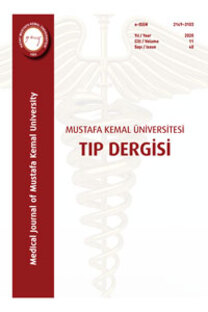LOMBER DİSK CERRAHİSİNE BİR TUZAK, PİRİFORMİS SENDROMU: DERLEME
Piriformis sendrom, Siyatik Sinir, Radikülopati
AN ENTRAPMENT FOR LUMBAR DİSC SURGERY, PİRİFORMİS SYNDROME: A COMPİLATİON
Piriformis syndrome, Sciaticnerve, Radiculopaty,
___
- Fishman, LM, Dombi, GW, Michaelsen, C, Ringel, SV, Rosbruch, J, Rosner, B, and Weber, C. Piriformis Syndrome: Diagnosis, treatment and outcome- a ten year study. Archives of Physical Medicine and Rehabilitation ,83 (3): 295-302, 2002.
- Filler AG, Haynes J, Jordan SE,Prager J, Villablanca P, Farahani K, McBride DQ, Tsuruda JS, Morisoli B, Batzdorf U, Johnson JP. Sciatica of nondisc origin and piriformissyndrome:diagnosis by magnetic resonance neurography and interventional magnetic resonance imaging with outcome study of resulting treatment. J Neurosurg Spine, 2: 99-115, 2005
- Fishman, LM, Shaffer, MF. The Piriformis Syndrome is Underdiagnosed. Muscle and Nerve.83: 626-629, 2003.
- Kirschner JS, Foye PM, Cole JL.Piriformis syndrome, diagnosis and treatment".Muscle Nerve40 (1): 10–8,2009.
- Lewis AM, Layzer R, Engstrom JW, Barbaro NM, Chin CT. Magnetic resonance neurography in extraspinal sciatica. Arch. Neurol.63 (10): 1469–72,2006.
- Deyo RA, Weinstein JN (). Low back pain.N. Engl. J. Med.344 (5): 363–70.
- Smoll NR. Variations of the Piriformis and Sciatic Nerve With Clinical Consequence: A Review. Clinical Anatomy. 23 (1): 8–17,2010.
- Anatomic considerations, a new injection technique, and a review of the literature". Anesthesiology, 98 (6): 1442–8,2001.
- Kuncewicz E, Gajewska E, Sobieska M, Samborski W. Piriformis muscle syndrome. Annales Academiae Medicae Stetinensis. 52 (3): 99–101; discussion 101, 2006.
- Lang AM. Botulinum toxin type B in piriformis syndrom.Am J Phys Med Rehabil.83 (3): 198–202, 2004
- ISSN: 2149-3103
- Yayın Aralığı: 3
- Başlangıç: 2010
- Yayıncı: Hatay Mustafa Kemal Üniversitesi Tıp Fakültesi Dekanlığı
NADİR BİR EFFÜZYON NEDENİ: PERGOLİD
Yasemin Büyükkarabacak, Aysen Şengül, Tülin Yetim, Ahmet Başoğlu
Özlem Kaya, Berna Hamamcı, Erkan Yula, Melek İnci, Vicdan Motor, Sadık Kaya, Ali Karakuş, Çetin Kılınç
LOMBER DİSK CERRAHİSİNE BİR TUZAK, PİRİFORMİS SENDROMU: DERLEME
Ali KARAKUŞ, Akın AYDOĞAN, Seçkin AKKÜÇÜK, Mehmet DURU, Güven KUVANDIK
NÖRAL TÜP DEFEKTLİ HASTALARA RETROSPEKTİF BAKIŞ
Murat Altaş, Mustafa Aras, Zeynep Altaş, Zinnur Aras, Yurdal Serarslan, Nebi Yılmaz
